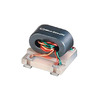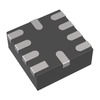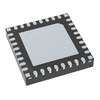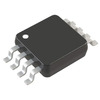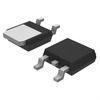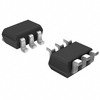Understanding TVS Diodes | How They Safeguard Against Voltage Spikes
Transient voltage spikes—brief, intense surges in voltage—can severely damage electronic circuits. These spikes vary in duration & intensity, from nanoseconds to milliseconds, and can arise from everyday events like powering a motor or static discharge. To protect electronics, Transient Voltage Suppression (TVS) diodes act swiftly to clamp down on overvoltages, safeguarding sensitive devices. In this article, we’ll explore how TVS diodes work, how to use them, & where they’re most needed.
Catalog
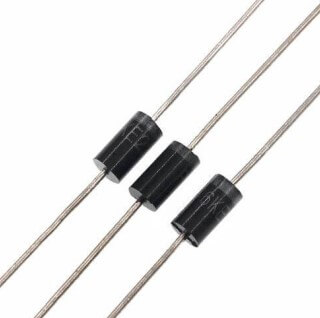
Figure 1: TVS Diodes
TVS Diodes Explained
Transient Voltage Suppressor (TVS) diodes are used for protecting electronic circuits from sudden voltage spikes, similar to how surge protector work. They quickly detect these surges & clamp the voltage to a safe level, thus, preventing damage to the circuit. This function is important for sensitive electronic devices where even minor voltage fluctuations can cause significant issues.

Figure 2: TVS Diode Protection
TVS diodes feature a larger P-N junction compared to standard diodes. This feature improves their ability to dissipate large surge currents efficiently. They are designed to activate at a specific breakdown voltage that is lower than the maximum voltage rating of the protected components. This design ensures immediate activation, reducing the risk of damage from electrical disturbances like lightning strikes, electrostatic discharges (ESD), electrical fast transients (EFT), & inductive load switching.
TVS Diode Function
Transients can originate from both internal circuit complexities & external environmental factors, varying in frequency, intensity, & duration. The unpredictable nature of these disturbances makes TVS diodes important for reliable circuit protection.
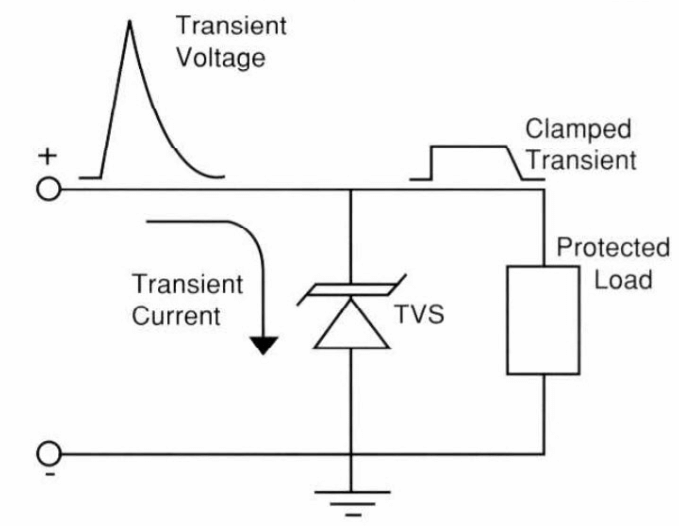
Figure 3: How Do TVS Diodes Work
TVS diodes function as dynamic protectors within electronic circuits. Positioned in parallel to the circuit they protect, they monitor voltage levels continuously. When a voltage spike exceeds safe levels, the TVS diode activates its clamping mechanism. This rapid response limits the voltage by reducing it to a safe threshold & diverting the excess current to the ground. The diode's clamping action is precisely tuned to activate only during a voltage spike. That will guarantee normal circuit operations remain unaffected under standard conditions.
The quick action of TVS diodes to electrical surges mitigate the effects of various electrical disturbances, including lightning strikes, power anomalies, & electrostatic discharges. Such protection is relevant in fields like telecommunications or high-frequency applications. By clamping excessive voltages & redirecting them away from the circuit, TVS diodes preserve the integrity & functionality of electronic systems.
TVS Diode Varieties
TVS diodes come in both through-hole & surface-mounted forms, fitting various assembly requirements. Their types include unidirectional and bidirectional diodes, each catering to specific circuit needs. This classification ensures that the diodes effectively manage electrical threats from regular operations or external disturbances, regardless of the circuit's complexity.
Automotive TVS Diode
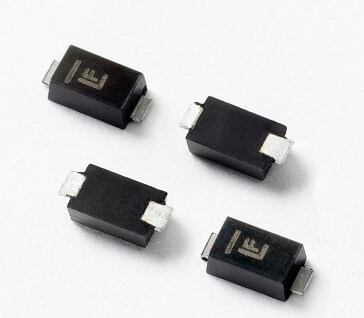
Figure 4: Automotive TVS Diode
In the automotive industry, TVS diodes protect electronic systems from high-energy transients like alternator load dumps or field decay. Placed strategically within automotive electrical systems, these diodes protect sensitive components from transient spikes. It improves the durability & reliability of automotive electronics in harsh conditions.
Zener Diode

Figure 5: Zener diodes
Zener diodes, a type of TVS diode, are known for their precision in managing voltage levels. They operate near a specific breakdown voltage & maintain a stable current even during voltage fluctuations. This makes them ideal for creating voltage references & protecting circuits from overvoltage & electrostatic discharge (ESD). They are useful in high-frequency circuits & data lines.
Bidirectional Diode
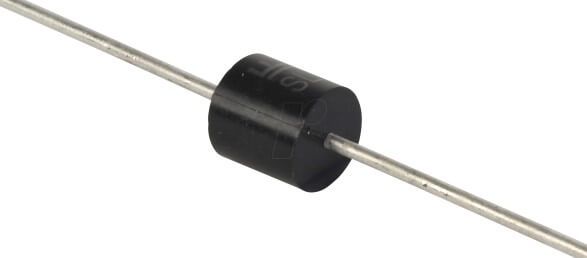
Figure 6: Bidirectional Diode
Bidirectional TVS diodes handle voltage fluctuations in both positive & negative directions. They offer more versatility than unidirectional variants. This capability is beneficial in complex electronic systems where voltage transients can occur from multiple directions, requiring robust protection.
ESD Diode

Figure 7: ESD diodes
ESD diodes are specialized TVS diodes designed to protect integrated circuits (ICs) from high-voltage electrostatic discharges. They absorb excess voltage & provide a low-impedance path to ground and prevent malfunctions or damage during ESD events. Their rapid response makes sure robust ESD protection in demanding applications.
Clamping Voltage Diode

Figure 8: Clamping Voltage Diodes
Clamping voltage diodes protect sensitive electronic components by clamping excess voltage. These diodes act quickly to mitigate transients, thus, keep voltage levels within safe operational limits. This prevents damage from electrical surges & preserve the integrity of sophisticated electronic systems.
Littelfuse Diode
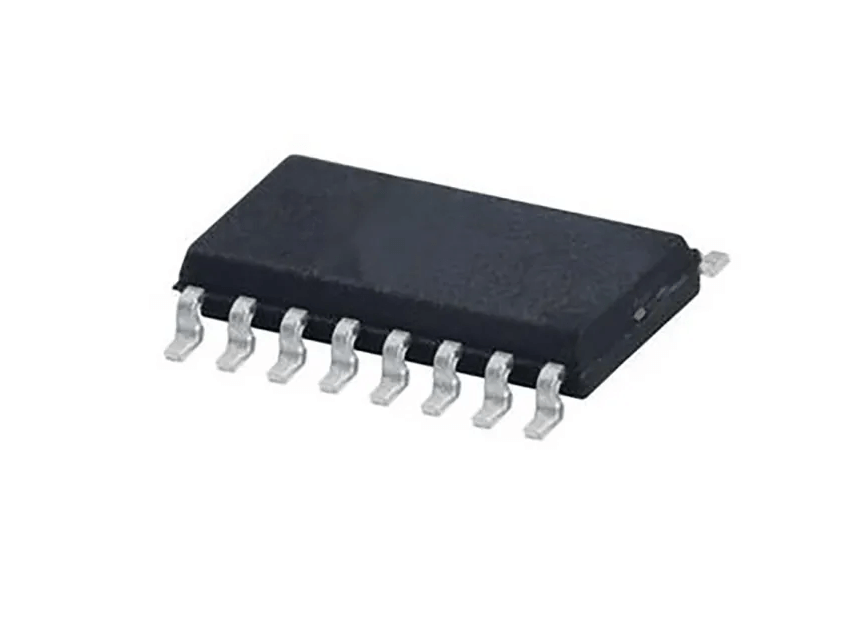
Figure 9: Littelfuse Diodes
Littelfuse diodes are known for their strong protective capabilities & wide application range. When selecting a Littelfuse diode, consider the specific environmental & operational demands of the circuit. Ensuring the diode's characteristics align with the protection needs guarantees optimal performance of the electronic components.
Transient Suppression Diode
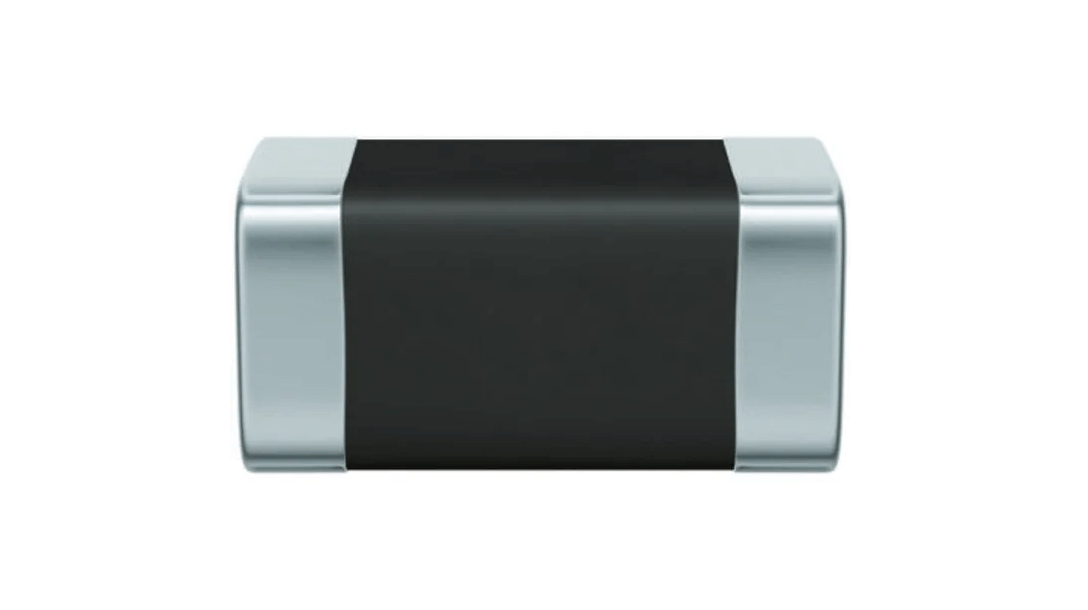
Figure 10: Transient Suppression Diodes
Transient Suppression Diodes, also called Transorbs. It mitigates transient voltages in moderate-frequency circuits. They are valued for their simplicity, effectiveness, & quick response, though their use may be limited by higher costs & reduced frequency range due to their high capacitance.
Protection Diode
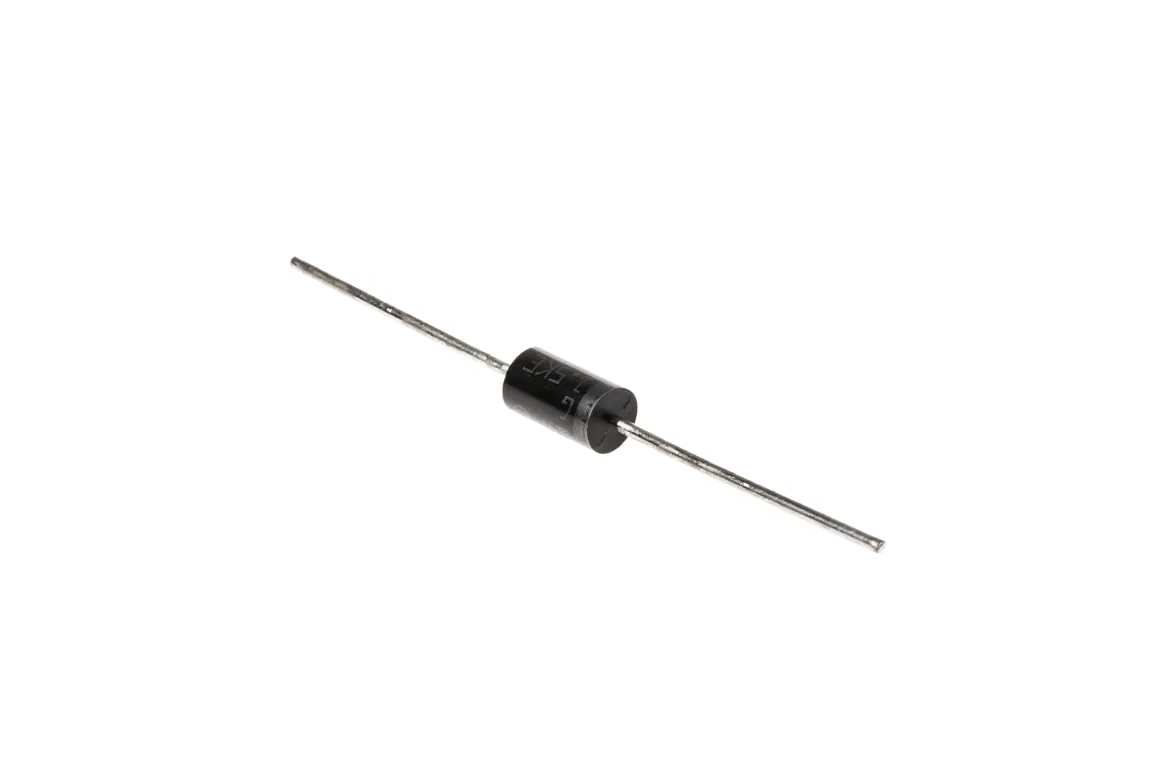
Figure 11: Protection diodes
Protection diodes are used in applications where current flows mainly in one direction. They protect against reverse voltages that might cause component failure. These diodes are chosen based on their peak reverse voltage ratings that should exceed the highest voltage the circuit might encounter. That will ensure robust protection against reverse currents.
Transil Diode
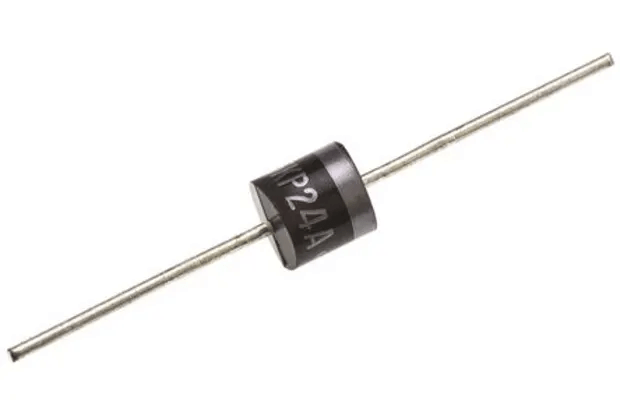
Figure 12: Transil Diodes
Transil diodes are versatile TVS diodes used in various applications, from PCs to medical & wireless communication systems. Their robustness against electrical stresses makes them valuable for protecting circuits from abrupt electrical spikes.
When to Use TVS Diodes ?
TVS diodes are widely used across various electronic applications. In computing devices, they protect sensitive components like microprocessors and MOS memory from voltage fluctuations. In telecommunications equipment, TVS diodes safeguard against surges that could disrupt communication systems.
They are also used to protect AC power lines from voltage spikes caused by external factors like lightning or internal issues such as equipment malfunctions. In both domestic & commercial electronic systems, including home appliances and entertainment units, TVS diodes makes sure reliable & safe operation under varying electrical conditions.
In automotive electronics, TVS diodes protect against transients induced by alternator load dumps, switching noises, & other sources of electrical interference. Their ability to divert excess current safely to the ground minimizes the risk of damage. Maintaining operational stability even in adverse environments.
Without TVS diode protection, electronic devices are much more at risk from damage caused by sudden voltage spikes. TVS diodes stop these spikes from exceeding the levels that sensitive components can handle. Without these diodes, voltage spikes can quickly cause serious damage, like short circuits, or gradually wear down the device’s performance over time. As a result, devices without TVS diodes often break down more frequently, requiring more repairs & part replacements that can be costly & disrupt normal operations.
Besides, in critical areas like medical or industrial settings, the stakes are even higher. For example, if medical equipment fails because of a voltage spike, it could endanger patient safety. Similarly, in industrial environments, a piece of equipment going down unexpectedly can halt production, leading to delays & problems. Therefore, not having TVS diodes not only affects the durability & function of electronic systems but also poses serious safety risks.
How to Utilized TVS Diodes?
TVS diodes are integrated into circuits in a parallel configuration, allowing continuous voltage monitoring without disrupting normal operations. This setup ensures the diodes can respond swiftly to voltage spikes while maintaining circuit functionality. Typically, TVS diodes exhibit high impedance, similar to an open circuit, minimizing power loss through leakage current, which is kept minimal to maintain circuit efficiency.
TVS diodes excel when a circuit experiences voltage spikes. In such events, the diode quickly shifts from its dormant state to a highly conductive state through avalanche breakdown. This rapid response mechanism reduces resistance, enabling the diode to handle & divert large currents away from the main circuit. This action protects sensitive components from overvoltages.
TVS diodes offer automatic resetting capability. After a voltage spike, when levels return to normal, the TVS diode resets to its high impedance state, stopping its conductive action. This reset happens without manual intervention, ensuring the diode is ready for any subsequent spikes immediately. This feature simplifies maintenance & enhances circuit safety. It provides continuous & consistent protection against irregular & unpredictable voltage transients.
Factors to Consider in Choosing TVS Diodes
Choosing the right TVS diode requires a comprehensive understanding of the circuit’s needs & its operating environment.
Configuration Considerations - Select between unidirectional & bidirectional diodes based on the expected voltage transients. Unidirectional diodes are suitable for DC applications with one-directional spikes. Bidirectional diodes are necessary for AC applications or where voltage transients might vary in polarity, offering protection across both directions.
Reverse Stand-Off Voltage - The Reverse Stand-Off Voltage (VR) represents the maximum voltage level at which the diode remains inactive. Ensuring that VR matches or exceeds the circuit's peak operating voltage prevents the diode from triggering during normal conditions. This matching avoids premature clamping or clipping of operational voltage that could lead to signal integrity issues or inefficiencies.
Breakdown Voltage - Breakdown Voltage (VBR) defines the voltage threshold at which the TVS diode begins to conduct & protect against surges. Specified at a test current, often 1mA, it indicates the voltage where the diode transitions from non-conductive to conductive, starting its protective action. The correct VBR setting ensures the diode activates precisely during voltage spikes, effectively managing excess voltage without causing unnecessary disruptions during normal fluctuations.
Clamping Voltage - Clamping Voltage (VC) determines the maximum voltage that the protected circuit will experience during a transient voltage spike. This level reflects the diode’s capability to limit voltage after breakdown. Typically provided under specific conditions, such as a standard test waveform, understanding VC help designers to assess the diode's protective efficacy. It indicates how well the diode can minimize damage by clamping excessive voltages to safer levels during sudden spikes.
Peak Pulse Current - Peak Pulse Current (IPP) denotes the maximum surge current the TVS diode can handle without deteriorating. Adequately rating the IPP ensures the TVS diode can protect sensitive circuitry by absorbing & diverting large currents during voltage spikes.
Physical Dimensions - Ensure the diode fits within the circuit layout's physical constraints without causing design compromises.
How to Install TVS Diodes?
Installing TVS diodes in an electronic circuit is a straightforward process but requires precision to guarantee effective protection against voltage spikes. Here's a simple step-by-step process on how to correctly integrate a TVS diode into an existing circuit:
Identify Sensitive Lines
Determine what parts of your circuit are most vulnerable to voltage spikes. These are typically lines connected to external interfaces, such as power supply lines, data lines, or any lines that interface with other hardware components. These are the areas where TVS diodes are most needed to protect sensitive electronic components from surges.
Determine the Correct Orientation of the Diode (Polarity)
TVS diodes have polarity. Meaning they must be connected in a specific direction to function correctly. Most TVS diodes will have markings to indicate the cathode & anode. Ensure that the diode is oriented according to the circuit’s polarity. Generally, the cathode should be connected to the more negative side of the circuit, & the anode to the more positive side.
Solder the TVS Diode Across the Line
Once you have identified the sensitive lines & determined the correct orientation, the next step is to physically install the TVS diode. Solder the TVS diode directly across the line where protection is required. It’s necessary to make solid & short connections to minimize any additional inductance that could affect the diode’s performance. Short, direct soldering ensures the TVS diode can respond quickly & effectively to any surges, thus, provide the best protection.
Conclusion
TVS diodes are essential parts of protecting electronic circuits. They work fast to control unexpected voltage spikes that can ruin electronic parts. We've seen how they work, how to put them in circuits, & how useful they are in many different electronic setups. Because these diodes act so quickly, they are very valuable in keeping sensitive electronics safe in many areas, from cars to communication systems. As electronics keep advancing, the need for effective protection like TVS diodes will grow.
Frequently Asked Questions [FAQ]
1. What is the difference between TVS diodes and regular Zener diodes?
TVS diodes are designed to handle sudden, high voltage spikes efficiently, unlike Zener diodes. They respond faster & can manage higher energy levels, making them better suited for protecting circuits.
2. Can TVS diodes be used repeatedly after clamping a large surge?
Yes, TVS diodes can handle multiple surges. However, their effectiveness might decrease if they face very strong or frequent surges, eventually requiring replacement to maintain protection.
3. How do I choose the right TVS diode for a specific application?
Choose a TVS diode by considering your circuit’s maximum voltage, the types of voltage spikes expected, & the energy the diode needs to handle. The diode’s clamping & breakdown voltages should fit your circuit’s sensitivity & voltage limits.
4. Are TVS diodes effective against all types of electrical transients?
TVS diodes are effective against most transients like ESD, lightning, & switching surges. For very long surges, other devices like varistors or suppressor circuits might be required.
5. What are the physical limitations of TVS diodes?
TVS diodes come in various sizes & shapes, determined by their voltage & energy capacities. Their size & heat dissipation abilities may limit where they can be used in a circuit.
6. How does temperature affect TVS diode performance?
The performance of TVS diodes can change with temperature. Typically, higher temperatures can lower the breakdown voltage, affecting the diode’s effectiveness. This must be considered when using diodes in very hot or cold environments.
7. Can TVS diodes be used in both AC and DC applications?
Yes, TVS diodes are flexible & can be used with both AC & DC. Unidirectional diodes are for DC, & bidirectional diodes are for AC, offering protection for both current flows.
8. Are TVS diodes visible in circuit diagrams?
Yes, TVS diodes are shown in circuit diagrams with special symbols that highlight their role in suppressing voltage spikes. Thus, it is easier to spot & understand their function.
9. How do I test if a TVS diode is still functional?
To check if a TVS diode is working, use a multimeter in diode mode to test its voltage response. For a more detailed test, apply a controlled voltage spike & measure if the diode clamps it correctly.
About us
ALLELCO LIMITED
Read more
Quick inquiry
Please send an inquiry, we will respond immediately.
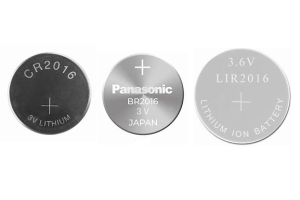
A Detailed Guide to CR2016, BR2016, LiR2016, and Their Battery Equivalents
on July 24th

A-Size Battery Equivalents and Replacements
on July 22th
Popular Posts
-

What is GND in the circuit?
on January 1th 2814
-

RJ-45 Connector Guide: RJ-45 Connector Color Codes, Wiring Schemes, R-J45 Applications, RJ-45 Datasheets
on January 1th 2398
-

Fiber Connector Types: SC Vs LC And LC Vs MTP
on January 1th 2008
-

Understanding Power Supply Voltages in Electronics VCC, VDD, VEE, VSS, and GND
on November 5th 1750
-

Comparison Between DB9 and RS232
on January 1th 1723
-

What Is An LR44 Battery?
Electricity, that ubiquitous force, quietly permeates every aspect of our daily lives, from trivial gadgets to life-threatening medical equipment, it plays a silent role. However, truly grasping this energy, especially how to store and efficiently output it, is no easy task. It is against this background that this article will focus on a type of coin cell battery that may seem insignificant on the...on January 1th 1673
-

Understanding the Fundamentals:Inductance Resistance, andCapacitance
In the intricate dance of electrical engineering, a trio of fundamental elements takes center stage: inductance, resistance, and capacitance. Each bears unique traits that dictate the dynamic rhythms of electronic circuits. Here, we embark on a journey to decipher the complexities of these components, to uncover their distinct roles and practical uses within the vast electrical orchestra. Inductan...on January 1th 1611
-

CR2430 Battery Comprehensive Guide: Specifications, Applications and Comparison to CR2032 Batteries
What is CR2430 battery ?Benefits of CR2430 BatteriesNormCR2430 Battery ApplicationsCR2430 EquivalentCR2430 VS CR2032Battery CR2430 SizeWhat to look for when buying the CR2430 and equivalentsData Sheet PDFFrequently Asked Questions Batteries are the heart of small electronic devices. Among the many types available, coin cells play a crucial role, commonly found in calculators, remote controls, and ...on January 1th 1483
-

CR2450 vs CR2032: Can The Battery Be Used Instead?
Lithium manganese batteries do have some similarities with other lithium batteries. High energy density and long service life are the characteristics they have in common. This kind of battery has won the trust and favor of many consumers because of its unique safety. Expensive tech gadgets? Small appliances in our homes? Look around and you'll see them everywhere. Among these many lithium-manganes...on January 1th 1466
-

What Is RF and Why Do We Use It?
Radio Frequency (RF) technology is a key part of modern wireless communication, enabling data transmission over long distances without physical connections. This article delves into the basics of RF, explaining how electromagnetic radiation (EMR) makes RF communication possible. We will explore the principles of EMR, the creation and control of RF signals, and their wide-ranging uses. The article ...on January 1th 1433





















